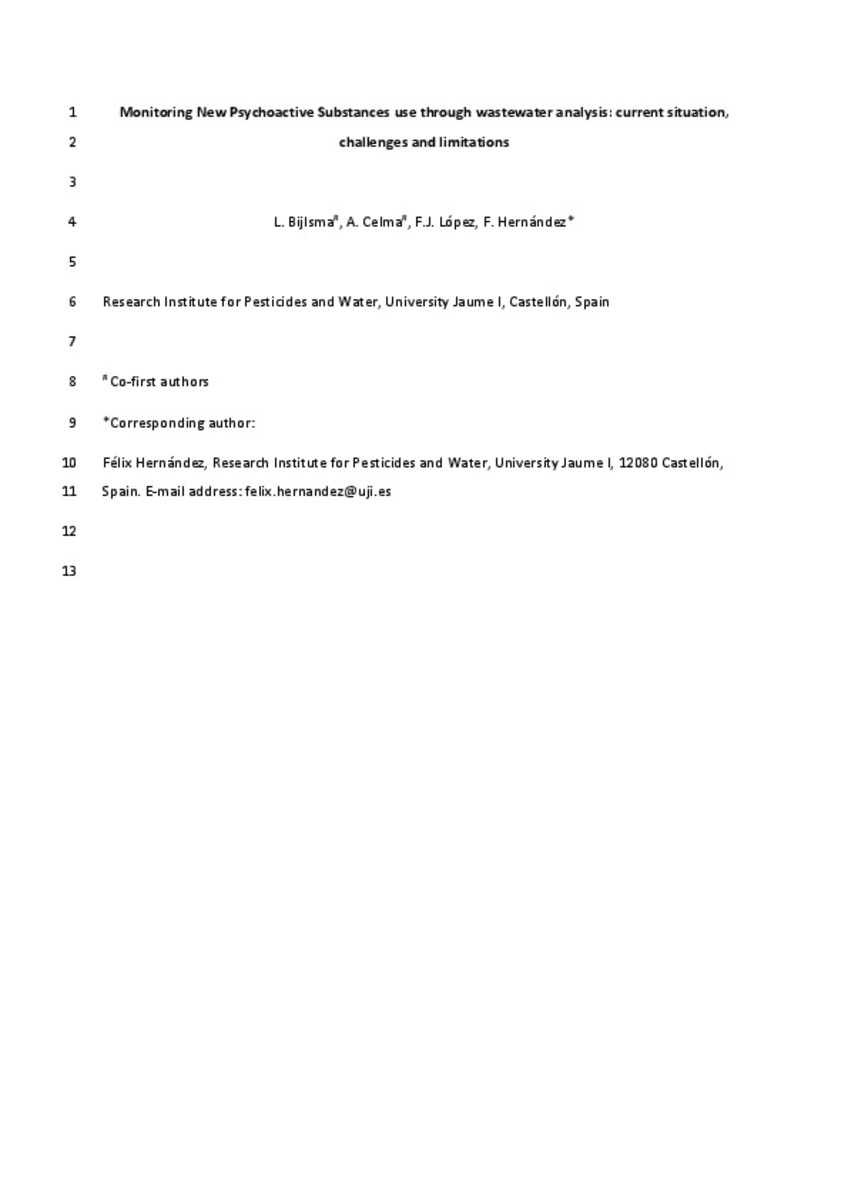Mostrar el registro sencillo del ítem
Monitoring new psychoactive substances use through wastewater analysis: current situation, challenges and limitations
| dc.contributor.author | Bijlsma, Lubertus | |
| dc.contributor.author | Celma, Alberto | |
| dc.contributor.author | Lopez, Francisco | |
| dc.contributor.author | Hernandez, Felix | |
| dc.date.accessioned | 2019-07-02T10:10:05Z | |
| dc.date.available | 2019-07-02T10:10:05Z | |
| dc.date.issued | 2019-06 | |
| dc.identifier.citation | BIJLSMA, L., et al. Monitoring New Psychoactive Substances use through wastewater analysis: current situation, challenges and limitations. Current Opinion in Environmental Science & Health, 2019, vol. 9, p. 1-12 | ca_CA |
| dc.identifier.issn | 2468-5844 | |
| dc.identifier.uri | http://hdl.handle.net/10234/183097 | |
| dc.description.abstract | New psychoactive substances (NPSs) are compounds that produce similar effects to those induced by illicit drugs (IDs), such as cocaine, cannabis, and amphetamines, but are not strictly regulated by international conventions. The consumption of NPSs is a growing public health problem in many communities. However, there is little knowledge regarding the extent and actual use of these new substances. Monitoring NPS use is arduous, and therefore, different sources of information need to be used to get more insight of the prevalence and diffusion of NPS use. Analysis of pooled urine and wastewater (WW) shows strong potential, giving a different and complementary light on this issue, although presents some limitations and challenges that must be taken into account. Liquid chromatography coupled with high-resolution mass spectrometry (LC-HRMS) is one of the most powerful approaches for screening a large number of NPSs because of the accurate-mass full-spectrum acquisition measurements. By using a comprehensive and updated NPS database, LC-HRMS is flexible enough to confront the ever-changing NPS market. In this “current opinion”, we give our point of view on the usefulness of pooled urine and WW analysis and on the potential application of wastewater-based epidemiology as source of information for NPS use, explaining the main bottlenecks and future perspectives in this emerging research field. | ca_CA |
| dc.format.extent | 12 p. | ca_CA |
| dc.language.iso | eng | ca_CA |
| dc.publisher | Elsevier | ca_CA |
| dc.relation.isPartOf | Current Opinion in Environmental Science & Health, 2019, vol. 9 | ca_CA |
| dc.rights | Copyright © Elsevier B.V. | ca_CA |
| dc.rights.uri | http://rightsstatements.org/vocab/InC/1.0/ | * |
| dc.subject | new psychoactive substances | ca_CA |
| dc.subject | pooled urine | ca_CA |
| dc.subject | urban wastewater | ca_CA |
| dc.subject | wastewater-based epidemiology | ca_CA |
| dc.subject | mass spectrometry | ca_CA |
| dc.title | Monitoring new psychoactive substances use through wastewater analysis: current situation, challenges and limitations | ca_CA |
| dc.type | info:eu-repo/semantics/article | ca_CA |
| dc.identifier.doi | https://doi.org/10.1016/j.coesh.2019.03.002 | |
| dc.relation.projectID | Spanish Ministry of Economy and Competitiveness: Project: CTQ2015-65603-P; Ministry of Economy and Competitiveness of Spain for his predoctoral grant: BES-2016-076914) | ca_CA |
| dc.rights.accessRights | info:eu-repo/semantics/openAccess | ca_CA |
| dc.relation.publisherVersion | https://www.sciencedirect.com/science/article/pii/S2468584418301181 | ca_CA |
| dc.type.version | info:eu-repo/semantics/submittedVersion | ca_CA |
Ficheros en el ítem
Este ítem aparece en la(s) siguiente(s) colección(ones)
-
IUPA_Articles [307]







